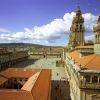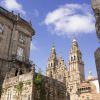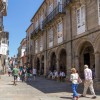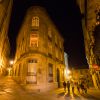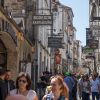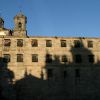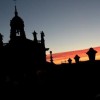- Accede I
- Regístrate I
- carrito
Plaza de Platerías
La plaza sur de la Catedral, que debe su nombre a los talleres de orfebres situados desde la Edad Media en los bajos asoportalados del claustro, está dominada por la única fachada románica que conserva la Catedral. Data del año 1078 o 1103 y fue severamente dañada durante los alzamientos populares contra el arzobispo Gelmírez, en la segunda década del siglo XII, por lo que fue reconstruida pocos años más tarde. En los siglos siguientes se le añadieron más figuras románicas procedentes de la llamada Puerta del Paraíso, al lado norte de la Catedral, para crear un conjunto de rica iconografía. En el friso conviven apóstoles, ángeles y signos zodiacales. El centro lo ocupa un estilizado Cristo, a cuyo lado está Santiago. En los portales, el tímpano de la izquierda parece representar la tentación de Cristo; el de la derecha, escenas de la Pasión claramente reconocibles: el juicio de Pilatos, la flagelación y la traición de Judas. Otras figuras como el rey David y la creación de Adán decoran los muros laterales.
El portal de Platerías está enmarcado por el arranque de la Torre del Reloj y el lienzo del claustro. Este muestra medallones renacentistas con escenas inspiradas en la tradición jacobea, como el traslado de sus reliquias o su transfiguración en guerrero. En la parte superior, los medallones corresponden a la genealogía de Cristo, y culminan, en la esquina derecha, con la figura de María y el Niño, pues el claustro está dedicado a la Virgen.
En el centro de la plaza, la Fuente de los Caballos se alza contra el fondo de la Casa del Cabildo, decorada con motivos geométricos típicos del barroco compostelano. Se trata de un verdadero telón de piedra de apenas tres metros de fondo, levantado por el arquitecto Fernández Sarela en 1758, con la intención de cerrar de manera casi teatral la plaza.
A su izquierda, en el arranque de la rúa do Vilar, se halla la Casa del Deán. Esta casa-palacio del siglo XVIII, obra de Fernández Sarela, fue hospedaje de los obispos que visitaban la ciudad.










